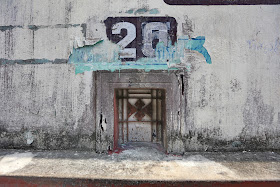For the past 7 years, the cinema has served me well as a conduit of inquiry into wider Southeast Asian society. From their dusty depths, the echos of yesterday have billowed out with torrential force, stirring forgottenisms that would have otherwise remained just that. Towns have gained context, cities have gained form, all from the memories of those involved in the world of the cinema. Bury your face in as many history text books as you can read, dear friends, you won't get a shred of the insight you would from breathing in that lung full of Histoplasmosis laden air in an abandoned movie theater.
As for the Globe Cinema - Narathiwat's lone claim to cinematic history - insights went undiscovered, I'm sorry to say. It was a hit-and-run mission. Arrive in town, locate theater informant and unbury its past. If no informants turn up after an hour or so, on to the next town. Much of my most recent tour of southern Thailand went down like that.
The Globe Cinema - a fixture of Narathiwat's streetscape since 1957.
Ticket windows indicative of a different era.
Looking closely at the number above the window, it's clear that the 0 in 20 was painted over to be a 5. 25 baht was likely the last and highest ticket price at The Globe before it went bust.
Ticket windows and queuing channels.
In lieu of hard data, what I can offer is a little seasoned conjecture as to the exigencies The Globe.
First of all, The Globe is the third theater in Thailand's deep south I came across that had a Western name related to the Cosmos. The other two, The Luna and The Aurora, are both in Yala province, albeit at opposite ends. The interrelated names that this trio shares might be simple coincidence, but it also could be a cultural distinction of Thailand's deep south. Historically, the deep south of Thailand has more in common with the Malay speaking world than with Thai. And for many years the Malay world was a colony of Great Britain, making English the primary language, especially when it came to such things as naming businesses and buildings.
As for the references to the cosmos, that's simply ornamental.
Architecturally, The Globe takes cues from the International Style, a movement which was spreading throughout the world in the years following World War 2. A few distinctions keep it from being definitive of the style, however. For one, other than the facade, the theater appears to be mostly wood. Views of the auditorium, not pictured in this series, reveal a clap-board wooden exterior, more akin to Thai vernacular theater building techniques than any formal architectural milieu. International Style is grounded in concrete, brick, stone and steel. Not wood.
The overall lack of ornamentation on the facade was not without good reason. What looks like design laziness was actually simple logic, as that dead space on the facade would be have been covered with vivid hand-painted movie billboards. Matched against the gold-painted moldings of the date (๒๕๐๐ - 1957) above and the name on the shaft tower ("เดอะ โกล๊ป ซีนีมา"), this would have been the most visually exciting building in town, if not the most exciting overall given its function.
Molded concrete signage, "The Globe Cinema," transliterated into Thai, "เดอะ โกล๊ป ซีนีมา"
Today, this relic of Narathiwat's cinematic past is a bird's nest harvesting house - a common adaptation for old movie theaters in Thailand's coastal provinces.
Dating to 1957, The Globe ranks fairly old for an extant Thai movie theater.
------------------------------------------------------------------------------------------------------------------------------------------------
Just a reminder, there are now only 3 copies remaining of The Movie Theater of Thailand photo portfolio. Once these are gone they will never be printed again. The entire box set is on sale here and here exclusively for $300 dollars each. For comparison, my photos currently on exhibition at H Gallery in Bangkok now are listed at $550 dollars for a single print. This set consists of 20, albeit much smaller images.
Get one of these while you can,
Get one of these while you can,









No comments:
Post a Comment